Multi-Omics Integration Reveals the Impact of Gastrointestinal Microbiota on Feed Efficiency in Tan Sheep
Abstract
1. Introduction
2. Materials and Methods
2.1. Experimental Animals and Feeding Management
2.2. Experimental Sample Collection
2.3. 16S rRNA Sequence Analysis of Rumen, Cecum, and Rectum Microorganisms
2.4. Metabonomic Analysis of Rumen Contents
2.5. Data Statistics and Analysis
3. Results
3.1. Analysis of Microbial Differences in Rumen, Cecum, and Rectum of Tan Sheep with High and Low FCRs
3.1.1. Analysis of Microbial Differences in the Rumen of Tan Sheep with High and Low FCRs
3.1.2. Analysis of Microbial Differences in the Cecum of Tan Sheep with High and Low FCRs
3.1.3. Analysis of Microbial Differences in the Rectum of Tan Sheep with High and Low FCRs
3.2. Analysis of Correlation Between Differential Microbes in Rumen, Cecum, and Rectum of Tan Sheep with High and Low FCRs
3.3. Analysis of Metabolite Differences in the Rumen of Tan Sheep with High and Low FCRs
3.4. Analysis of Correlation Between Rumen Microbes and Metabolites in Tan Sheep with High and Low FCRs
4. Discussion
5. Conclusions
Author Contributions
Funding
Institutional Review Board Statement
Informed Consent Statement
Data Availability Statement
Conflicts of Interest
Abbreviations
| FCR | Feed Conversion Ratio |
References
- Zhao, X.; Zuo, S.; Guo, Y.; Zhang, C.; Wang, Y.; Peng, S.; Liu, M.; Wang, B.; Zhang, H.; Luo, H. Carcass Meat Quality, Volatile Compound Profile, and Gene Expression in Tan Sheep under Different Feeding Regimes. Food Biosci. 2023, 56, 103213. [Google Scholar] [CrossRef]
- Peng, J.-J.; Zou, Y.; Li, Z.-X.; Liang, Q.-L.; Song, H.-Y.; Li, T.-S.; Ma, Y.-Y.; Zhu, X.-Q.; Zhou, D.-H. Prevalence and Multilocus Genotyping of Giardia Duodenalis in Tan Sheep (Ovis Aries) in Northwestern China. Parasitol. Int. 2020, 77, 102126. [Google Scholar] [CrossRef] [PubMed]
- Shi, A.; Lv, J.; Ma, Q.; Liu, Z.; Ma, L.; Zhou, J.; Tao, J. Study on the Expression Patterns of Inner Root Sheath-Specific Genes in Tan Sheep Hair Follicle during Different Developmental Stages. Gene 2024, 927, 148751. [Google Scholar] [CrossRef] [PubMed]
- McLoughlin, S.; Spillane, C.; Claffey, N.; Smith, P.E.; O’Rourke, T.; Diskin, M.G.; Waters, S.M. Rumen Microbiome Composition Is Altered in Sheep Divergent in Feed Efficiency. Front. Microbiol. 2020, 11, 1981. [Google Scholar] [CrossRef]
- Lu, M.-L.; Pan, L.; Zheng, C.; Mao, R.-Y.; Yuan, G.-H.; Shi, C.-Y.; Pu, Z.-H.; Su, H.-X.; Diao, Q.-Y.; Rehemujiang, H.; et al. Effects of Compound Microecological Preparation Supplementation on Production Performance and Nutrient Apparent Digestibility in Hu Sheep from the Rumen Perspective. Microorganisms 2025, 13, 999. [Google Scholar] [CrossRef]
- Zhang, Z.; Sun, Y.; Zhong, X.; Zhu, J.; Yang, S.; Gu, Y.; Yu, X.; Lu, Y.; Lu, Z.; Sun, X.; et al. Dietary Crude Protein and Protein Solubility Manipulation Enhances Intestinal Nitrogen Absorption and Mitigates Reactive Nitrogen Emissions through Gut Microbiota and Metabolome Reprogramming in Sheep. Anim. Nutr. 2024, 18, 57–71. [Google Scholar] [CrossRef]
- Frutos, P.; Toral, P.G.; Belenguer, A.; Hervás, G. Milk Fat Depression in Dairy Ewes Fed Fish Oil: Might Differences in Rumen Biohydrogenation, Fermentation, or Bacterial Community Explain the Individual Variation? J. Dairy Sci. 2018, 101, 6122–6132. [Google Scholar] [CrossRef]
- Huang, X.; Zhou, L.; You, X.; Han, H.; Chen, X.; Huang, X. Production Performance and Rumen Bacterial Community Structure of Hu Sheep Fed Fermented Spent Mushroom Substrate from Pleurotus Eryngii. Sci. Rep. 2023, 13, 8696. [Google Scholar] [CrossRef]
- Koh, A.; De Vadder, F.; Kovatcheva-Datchary, P.; Bäckhed, F. From Dietary Fiber to Host Physiology: Short-Chain Fatty Acids as Key Bacterial Metabolites. Cell 2016, 165, 1332–1345. [Google Scholar] [CrossRef]
- Gong, Z.; Ye, G.; Xu, S.; He, X. The Characteristics of Intestinal Flora of Tibetan Sheep in Different Regions at High Altitude Were Revealed Based on Metagenomic Technique. Heliyon 2024, 10, e34380. [Google Scholar] [CrossRef]
- Kono, I.; Inokuma, H.; Yoshihara, Y. Does Intestinal Bacteria Diversity Drive Multi-Dimensional Sheep (Ovis Aries) Health? Small Rumin. Res. 2023, 228, 107107. [Google Scholar] [CrossRef]
- Zhang, C.; Li, M.M.; Al-Marashdeh, O.; Gan, L.P.; Zhang, C.Y.; Zhang, G.G. Performance, Rumen Fermentation, and Gastrointestinal Microflora of Lambs Fed Pelleted or Unpelleted Total Mixed Ration. Anim. Feed Sci. Technol. 2019, 253, 22–31. [Google Scholar] [CrossRef]
- Kang, L.; Wang, W.; Yang, L.; Liu, T.; Zhang, T.; Xie, J.; Zhai, M.; Zhao, X.; Duan, Y.; Jin, Y. Effects of Feeding Patterns on Production Performance, Lipo-Nutritional Quality and Gut Microbiota of Sunit Sheep. Meat Sci. 2024, 218, 109642. [Google Scholar] [CrossRef] [PubMed]
- Li, Z.; Shen, J.; Xu, Y.; Zhu, W. Metagenomic Analysis Reveals Significant Differences in Microbiome and Metabolic Profiles in the Rumen of Sheep Fed Low N Diet with Increased Urea Supplementation. FEMS Microbiol. Ecol. 2020, 96, fiaa117. [Google Scholar] [CrossRef]
- Esfiokhi, S.M.; Norouzian, M.; Abadi, M.S.; Ahvanooei, M.R. Effects of Probiotic-Supplemented Milk Replacer on Growth, Blood Biochemistry, Fermentation, Digestibility, and Carcass Traits in Lambs. Vet. Anim. Sci. 2024, 25, 100368. [Google Scholar] [CrossRef]
- Huang, W.; Cui, K.; Han, Y.; Chai, J.; Wang, S.; Lü, X.; Diao, Q.; Zhang, N. Long Term Effects of Artificial Rearing before Weaning on the Growth Performance, Ruminal Microbiota and Fermentation of Fattening Lambs. J. Integr. Agric. 2022, 21, 1146–1160. [Google Scholar] [CrossRef]
- Mohapatra, A.; Trivedi, S.; Tejpal, C.S.; Aware, M.J.; Vaswani, S.; Prajapati, V.J.; Kolte, A.P.; Malik, P.K.; Sahoo, A.; Ravishankar, C.N.; et al. Effect of Two Selected Levels of Padina Gymnospora Biowaste and Enteric Methane Emission, Nutrient Digestibility, and Rumen Metagenome in Growing Sheep. Microorganisms 2025, 13, 780. [Google Scholar] [CrossRef]
- Abudabos, A.M.; Abdelrahman, M.M.; Alatiyat, R.M.; Aljumaah, M.R.; Al Jassim, R.; Stanley, D. Effect of Dietary Inclusion of Graded Levels of Distillers Dried Grains with Solubles on the Performance, Blood Profile and Rumen Microbiota of Najdi Lambs. Heliyon 2021, 7, e05683. [Google Scholar] [CrossRef]
- Guo, Y.; Yang, R.; Duan, C.; Wang, Y.; Hao, Q.; Ji, S.; Yan, H.; Zhang, Y.; Liu, Y. Effect of Dioscorea Opposite Waste on Growth Performance, Blood Parameters, Rumen Fermentation and Rumen Bacterial Community in Weaned Lambs. J. Integr. Agric. 2023, 22, 1833–1846. [Google Scholar] [CrossRef]
- Fu, C.; Shah, A.A.; Khan, R.U.; Khan, M.S.; Wanapat, M. Emerging Trends and Applications in Health-Boosting Microorganisms-Specific Strains for Enhancing Animal Health. Microb. Pathog. 2023, 183, 106290. [Google Scholar] [CrossRef]
- Tom, W.A.; Judy, J.V.; Kononoff, P.J.; Fernando, S.C. Influence of Empirically Derived Filtering Parameters, Amplicon Sequence Variant, and Operational Taxonomic Unit Pipelines on Assessing Rumen Microbial Diversity. J. Dairy Sci. 2024, 107, 9209–9234. [Google Scholar] [CrossRef] [PubMed]
- Bo Trabi, E.; Seddik, H.; Xie, F.; Lin, L.; Mao, S. Comparison of the Rumen Bacterial Community, Rumen Fermentation and Growth Performance of Fattening Lambs Fed Low-Grain, Pelleted or Non-Pelleted High Grain Total Mixed Ration. Anim. Feed Sci. Technol. 2019, 253, 1–12. [Google Scholar] [CrossRef]
- Yang, B.; Chen, H.; Liu, Y.; Luo, Y.; He, B.; Wang, S.; Wang, J. Alfalfa Intervention Alters the Colonization of Rumen Epithelial Bacteria to Promote Rumen Development and Lamb Health during Early Life. Anim. Feed Sci. Technol. 2023, 306, 115797. [Google Scholar] [CrossRef]
- Mavrommatis, A.; Severgnini, M.; Cremonesi, P.; Kyriakaki, P.; Christodoulou, C.; Petropoulos, K.; Dunière, L.; Kotsampasi, B.; Castiglioni, B.; Balaskas, C.; et al. The Impact of Probiotic Live Yeast in a Barley Grain-Based Diet on Rumen Microbial Communities, Fermentation, and Histology of Artificially Reared Lambs. Anim. Feed Sci. Technol. 2025, 322, 116269. [Google Scholar] [CrossRef]
- Grabner, E.; Stare, E.; Fanedl, L.; Zorec, M.; Jones, D.S.; Johnston, C.D.; Avguštin, G.; Accetto, T. Expanding the Rumen Prevotella Collection: The Description of Prevotella Communis, Sp. Nov. of Ovine Origin. Syst. Appl. Microbiol. 2023, 46, 126437. [Google Scholar] [CrossRef]
- Gao, Q.; Li, K.; Zhong, R.; Long, C.; Liu, L.; Chen, L.; Zhang, H. Supplementing Glycerol to Inoculum Induces Changes in pH, SCFA Profiles, and Microbiota Composition in In-Vitro Batch Fermentation. Fermentation 2021, 8, 18. [Google Scholar] [CrossRef]
- Granatto, C.F.; Grosseli, G.M.; Sakamoto, I.K.; Fadini, P.S.; Varesche, M.B.A. Influence of Cosubstrate and Hydraulic Retention Time on the Removal of Drugs and Hygiene Products in Sanitary Sewage in an Anaerobic Expanded Granular Sludge Bed Reactor. J. Environ. Manag. 2021, 299, 113532. [Google Scholar] [CrossRef]
- Janarthanan, O.M.; Laycock, B.; Montano-Herrera, L.; Lu, Y.; Arcos-Hernandez, M.V.; Werker, A.; Pratt, S. Fluxes in PHA-Storing Microbial Communities during Enrichment and Biopolymer Accumulation Processes. New Biotechnol. 2016, 33, 61–72. [Google Scholar] [CrossRef]
- Mao, S.Y.; Zhang, R.Y.; Wang, D.S.; Zhu, W.Y. Impact of Subacute Ruminal Acidosis (SARA) Adaptation on Rumen Microbiota in Dairy Cattle Using Pyrosequencing. Anaerobe 2013, 24, 12–19. [Google Scholar] [CrossRef]
- Xie, G.; Duff, G.C.; Hall, L.W.; Allen, J.D.; Burrows, C.D.; Bernal-Rigoli, J.C.; Dowd, S.E.; Guerriero, V.; Yeoman, C.J. Alteration of Digestive Tract Microbiome in Neonatal Holstein Bull Calves by Bacitracin Methylene Disalicylate Treatment and Scours. J. Anim. Sci. 2013, 91, 4984–4990. [Google Scholar] [CrossRef]
- Huang, J.; Sheng, Y.; Jia, X.; Qian, W.; Li, Z. Comparative Analysis of Microbial–Short-Chain Fatty Acids–Epithelial Transport Axis in the Rumen Ecosystem Between Tarim Wapiti (Cervus Elaphus Yarkandensis) and Karakul Sheep (Ovis Aries). Microorganisms 2025, 13, 1111. [Google Scholar] [CrossRef] [PubMed]
- Li, A.; Yang, Y.; Zhang, Y.; Lv, S.; Jin, T.; Li, K.; Han, Z.; Li, Y. Microbiome Analysis Reveals the Alterations in Gut Microbiota in Different Intestinal Segments of Yimeng Black Goats. Microb. Pathog. 2021, 155, 104900. [Google Scholar] [CrossRef] [PubMed]
- Wang, J.; Fan, H.; Han, Y.; Zhao, J.; Zhou, Z. Characterization of the Microbial Communities along the Gastrointestinal Tract of Sheep by 454 Pyrosequencing Analysis. Asian-Australas J. Anim. Sci. 2016, 30, 100–110. [Google Scholar] [CrossRef] [PubMed]
- Zhang, B.; Wang, X.; Ding, Z.; Kang, Y.; Guo, S.; Cao, M.; Hu, L.; Xiong, L.; Pei, J.; Guo, X. Effects of High-Concentrate Diets on Growth Performance, Serum Biochemical Indexes, and Rumen Microbiota in House-Fed Yaks. Animals 2024, 14, 3594. [Google Scholar] [CrossRef]
- Yin, X.; Ji, S.; Duan, C.; Ju, S.; Zhang, Y.; Yan, H.; Liu, Y. Rumen Fluid Transplantation Affects Growth Performance of Weaned Lambs by Altering Gastrointestinal Microbiota, Immune Function and Feed Digestibility. Animal 2021, 15, 100076. [Google Scholar] [CrossRef]
- Tian, X.-Z.; Li, J.-X.; Luo, Q.-Y.; Zhou, D.; Long, Q.-M.; Wang, X.; Lu, Q.; Wen, G.-L. Effects of Purple Corn Anthocyanin on Blood Biochemical Indexes, Ruminal Fluid Fermentation, and Rumen Microbiota in Goats. Front. Vet. Sci. 2021, 8, 715710. [Google Scholar] [CrossRef]
- Manju, G.U.; Nagalakshmi, D.; Balakrishanan, U.; Nagabhushana, V.; Venkateswarlu, M.; Rajanna, N.; Preetham, V.C.; Sriharsha, K.V.S. Effect of Feeding Slow Release Non Protein Nitrogen Sources on Nutrient Utilization, Rumen Fermentation Pattern, Microbial Protein Supply and Bacterial Diversity in Deccani Rams. Anim. Nutr. Feed Technol. 2022, 22, 79–94. [Google Scholar] [CrossRef]
- Gomes Carvalho Alves, K.L.; Granja-Salcedo, Y.T.; Messana, J.D.; Carneiro De Souza, V.; Generoso Ganga, M.J.; Detogni Colovate, P.H.; Kishi, L.T.; Berchielli, T.T. Rumen Bacterial Diversity in Relation to Nitrogen Retention in Beef Cattle. Anaerobe 2021, 67, 102316. [Google Scholar] [CrossRef]
- Lei, W.; Qi, M.; Tan, P.; Yang, S.; Fan, L.; Li, H.; Gao, Z. Impact of Polyphenol-Loaded Edible Starch Nanomaterials on Antioxidant Capacity and Gut Microbiota. Int. J. Biol. Macromol. 2024, 265, 130979. [Google Scholar] [CrossRef]
- Li, H.; Tan, P.; Lei, W.; Yang, S.; Fan, L.; Yang, T.; Guo, C.; Gao, Z. Investigation the Nutritional Properties of Auricularia Auricula Pulp Fermented with Lactobacillus Strains and Their Effects on Gut Microbiota. J. Sci. Food Agric. 2024, 104, 2502–2517. [Google Scholar] [CrossRef]
- Bush, J.R.; Alfa, M.J. Increasing Levels of Parasutterella in the Gut Microbiome Correlate with Improving Low-Density Lipoprotein Levels in Healthy Adults Consuming Resistant Potato Starch during a Randomised Trial. BMC Nutr. 2020, 6, 72. [Google Scholar] [CrossRef] [PubMed]
- Congiu, M.; Lourenco, J.; Cesarani, A.; Lamichhane, U.; Macciotta, N.P.P.; Dimauro, C. Predicting Feed Efficiency of Angus Steers Using the Gastrointestinal Microbiome. animal 2024, 18, 101102. [Google Scholar] [CrossRef] [PubMed]
- Zhu, W.; Su, Z.; Xu, W.; Sun, H.X.; Gao, J.F.; Tu, D.F.; Ren, C.H.; Zhang, Z.J.; Cao, H.G. Garlic Skin Induces Shifts in the Rumen Microbiome and Metabolome of Fattening Lambs. Animal 2021, 15, 100216. [Google Scholar] [CrossRef] [PubMed]
- Brusilow, S.W. Phenylacetylglutamine May Replace Urea as a Vehicle for Waste Nitrogen Excretion. Pediatr. Res. 1991, 29, 147–150. [Google Scholar] [CrossRef]
- Cederbaum, S.D.; Edwards, J.; Kellmeyer, T.; Peters, Y.; Steiner, R.D. Taste-Masked Formulation of Sodium Phenylbutyrate (ACER-001) for the Treatment of Urea Cycle Disorders. Mol. Genet. Metab. 2023, 138, 107558. [Google Scholar] [CrossRef]
- Heianza, Y.; Tiwari, S.; Wang, X.; Watrous, J.D.; Rexrode, K.M.; Hu, F.B.; Alotaibi, M.; Jain, M.; Sun, Q.; Manson, J.E.; et al. Gut-Microbiota-Related Metabolite Phenylacetylglutamine and Risk of Incident Coronary Heart Disease Among Women. J. Clin. Endocrinol. Metab. 2025, 110, e1531–e1539. [Google Scholar] [CrossRef]
- Ma, L.; Fu, G.; Liu, R.; Zhou, F.; Dong, S.; Zhou, Y.; Lou, J.; Wang, X. Phenylacetyl Glutamine: A Novel Biomarker for Stroke Recurrence Warning. BMC Neurol. 2023, 23, 74. [Google Scholar] [CrossRef]
- Li, B.; Hou, P.; Liu, L.; Zhao, L.; Zhang, X.; Yang, C.; Huang, X.; Ge, T.; Zheng, J.; Wen, Y.; et al. Effects of the Dietary Protein Level on Growth Performance, Nitrogen Metabolism, Serum Biochemical Index, and Meat Quality of Suffolk×Hu F1 Lambs. J. Agric. Food Res. 2025, 21, 101808. [Google Scholar] [CrossRef]
- Benhissi, H.; Medjadbi, M.; Charef, S.E.; Atxaerandio, R.; Ruiz, R.; Mandaluniz, N.; Goiri, I.; García-Rodríguez, A. Probiotic-Inoculated Biochar as a Feed Additive for Dairy Sheep: Effect on Apparent Digestibility, Microbial Protein Supply, Methane Emissions and Productive Performance. Anim. Feed Sci. Technol. 2025, 321, 116257. [Google Scholar] [CrossRef]
- Zeng, H.; Yin, Y.; Chen, L.; Xu, Z.; Luo, Y.; Wang, Q.; Yang, B.; Wang, J. Alterations in Nutrient Digestion and Utilization Associated with Different Residual Feed Intake in Hu Sheep. Anim. Nutr. 2023, 13, 334–341. [Google Scholar] [CrossRef]
- Sinha, A.K.; Laursen, M.F.; Brinck, J.E.; Rybtke, M.L.; Hjørne, A.P.; Procházková, N.; Pedersen, M.; Roager, H.M.; Licht, T.R. Dietary Fibre Directs Microbial Tryptophan Metabolism via Metabolic Interactions in the Gut Microbiota. Nat. Microbiol. 2024, 9, 1964–1978. [Google Scholar] [CrossRef] [PubMed]
- Hu, X.; Pang, N.; Wang, H.; Wang, Z.; Li, F.; Yang, J.; Yu, J.; Yang, Y.; Sun, M.; Lv, S. Effects of Sucralose Supplementation on Rumen Bacterial Community, Kynuronine Pathway and Feeding Behavior in Small-Tailed Han Sheep. Anim. Feed Sci. Technol. 2025, 323, 116287. [Google Scholar] [CrossRef]
- Wang, J.; Ding, L.; Yu, X.; Wu, F.; Zhang, J.; Chen, P.; Qian, S.; Wang, M. Tryptophan Improves Antioxidant Capability and Meat Quality by Reducing Responses to Stress in Nervous Hu Sheep. Meat Sci. 2023, 204, 109267. [Google Scholar] [CrossRef] [PubMed]
- Meng, L.; Jin, X.; Song, W.; Zhang, R.; Tong, M.; Qi, Z.; Mi, L. Dietary Selenium Levels Affect Mineral Absorbability, Rumen Fermentation, Microbial Composition and Metabolites of the Grazing Sheep. Anim. Feed Sci. Technol. 2024, 308, 115877. [Google Scholar] [CrossRef]
- Wu, Z.; Hou, Y.; Hu, S.; Bazer, F.W.; Meininger, C.J.; McNeal, C.J.; Wu, G. Catabolism and Safety of Supplemental L-Arginine in Animals. Amino Acids 2016, 48, 1541–1552. [Google Scholar] [CrossRef]
- Robinson, M.; Turnbull, S.; Lee, B.Y.; Leonenko, Z. The Effects of Melatonin, Serotonin, Tryptophan and NAS on the Biophysical Properties of DPPC Monolayers. Biochim. Biophys. Acta (BBA) Biomembr. 2020, 1862, 183363. [Google Scholar] [CrossRef]
- Guerreiro, O.; Francisco, A.E.; Alves, S.P.; Soldado, D.; Cachucho, L.; Chimenos, A.U.; Duarte, F.; Santos-Silva, J.; Bessa, R.J.B.; Jerónimo, E. Inclusion of the Aerial Part and Condensed Tannin Extract from Cistus Ladanifer L. in Lamb Diets–Effects on Rumen Microbial Community and Fatty Acid Profile. Anim. Feed Sci. Technol. 2022, 291, 115398. [Google Scholar] [CrossRef]
- Hassan, F.; Guo, Y.; Li, M.; Tang, Z.; Peng, L.; Liang, X.; Yang, C. Effect of Methionine Supplementation on Rumen Microbiota, Fermentation, and Amino Acid Metabolism in In Vitro Cultures Containing Nitrate. Microorganisms 2021, 9, 1717. [Google Scholar] [CrossRef]
- Rocchetti, G.; Becchi, P.P.; Salis, L.; Lucini, L.; Cabiddu, A. Impact of Pasture-Based Diets on the Untargeted Metabolomics Profile of Sarda Sheep Milk. Foods 2022, 12, 143. [Google Scholar] [CrossRef]
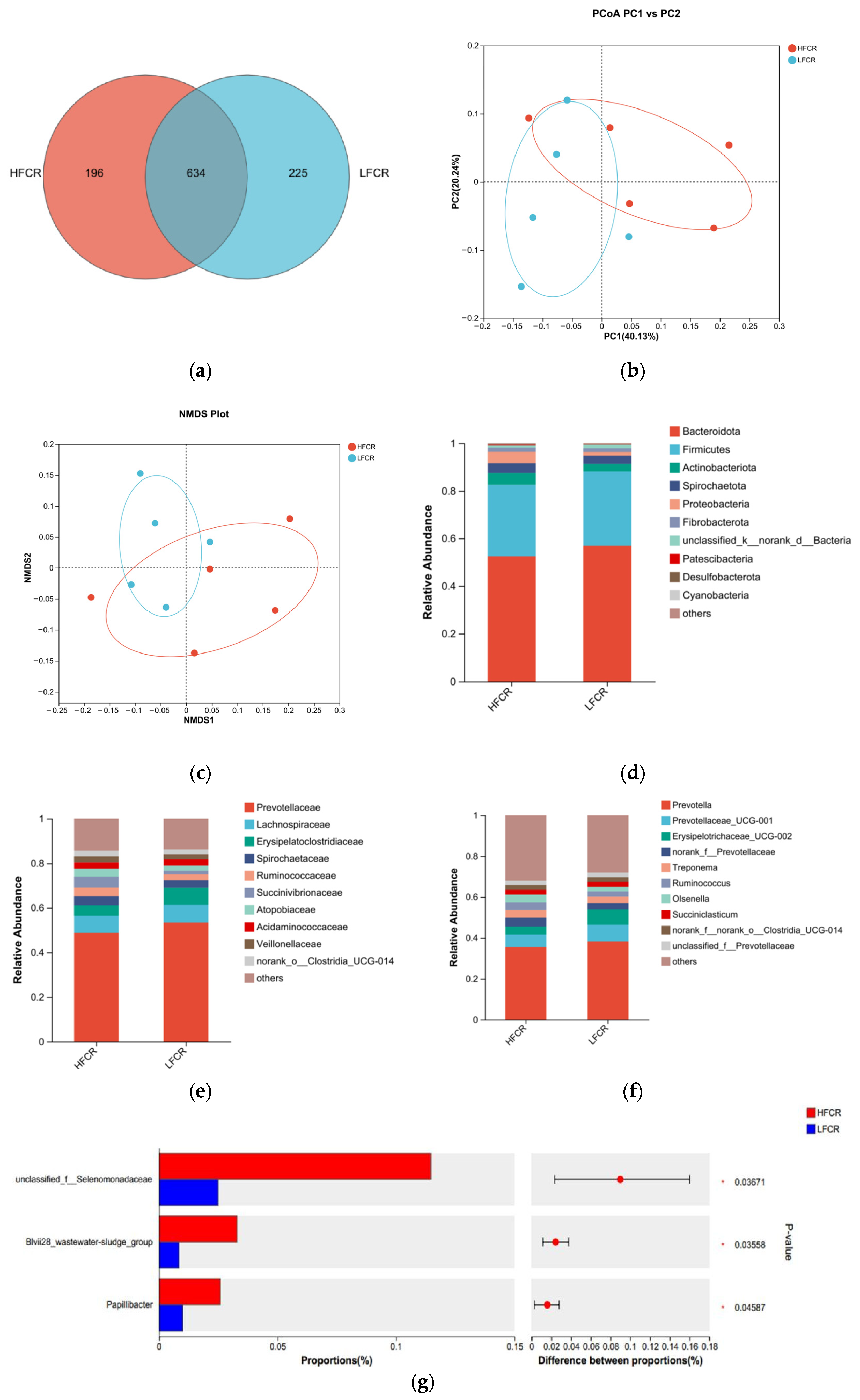

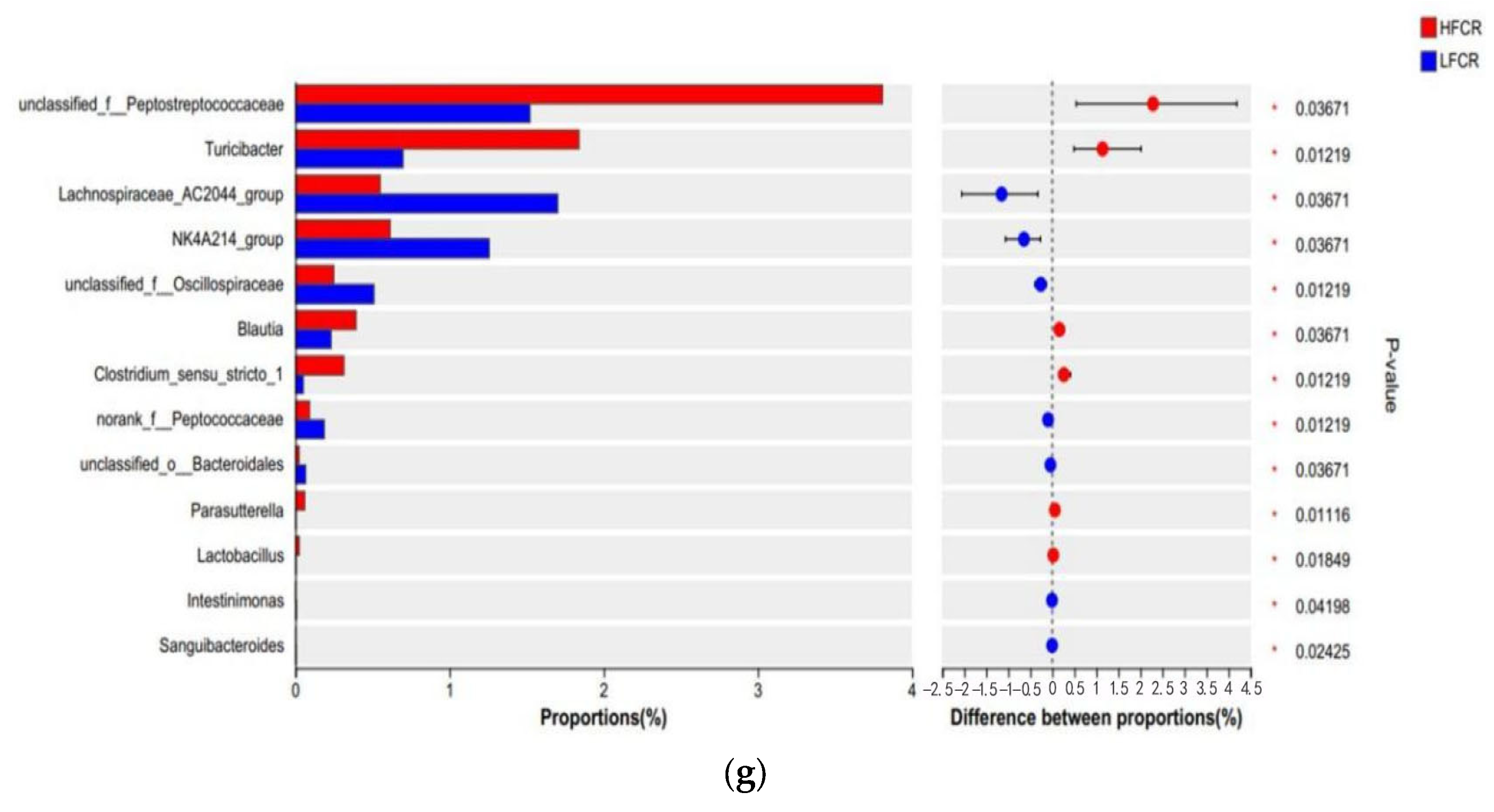
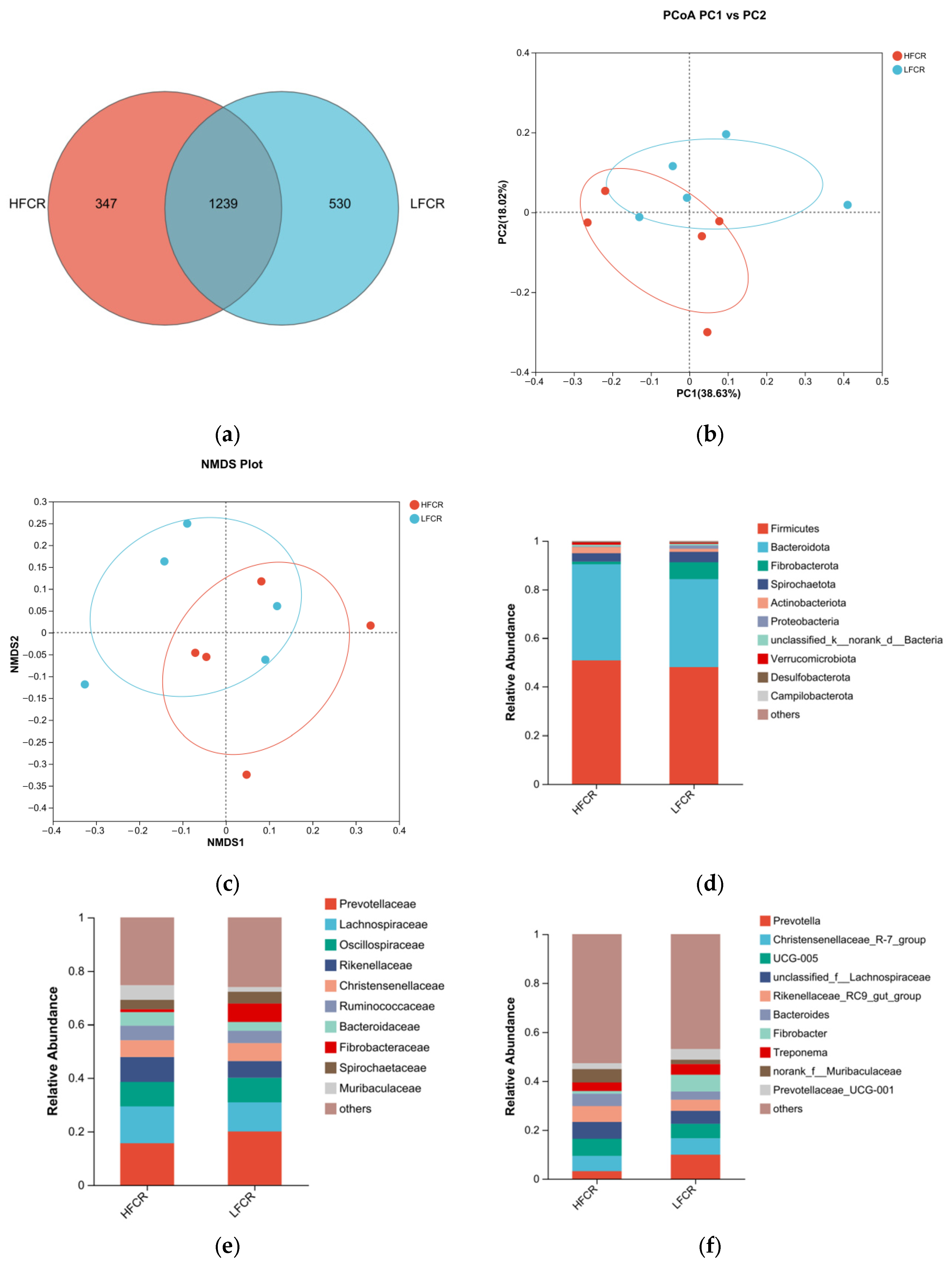
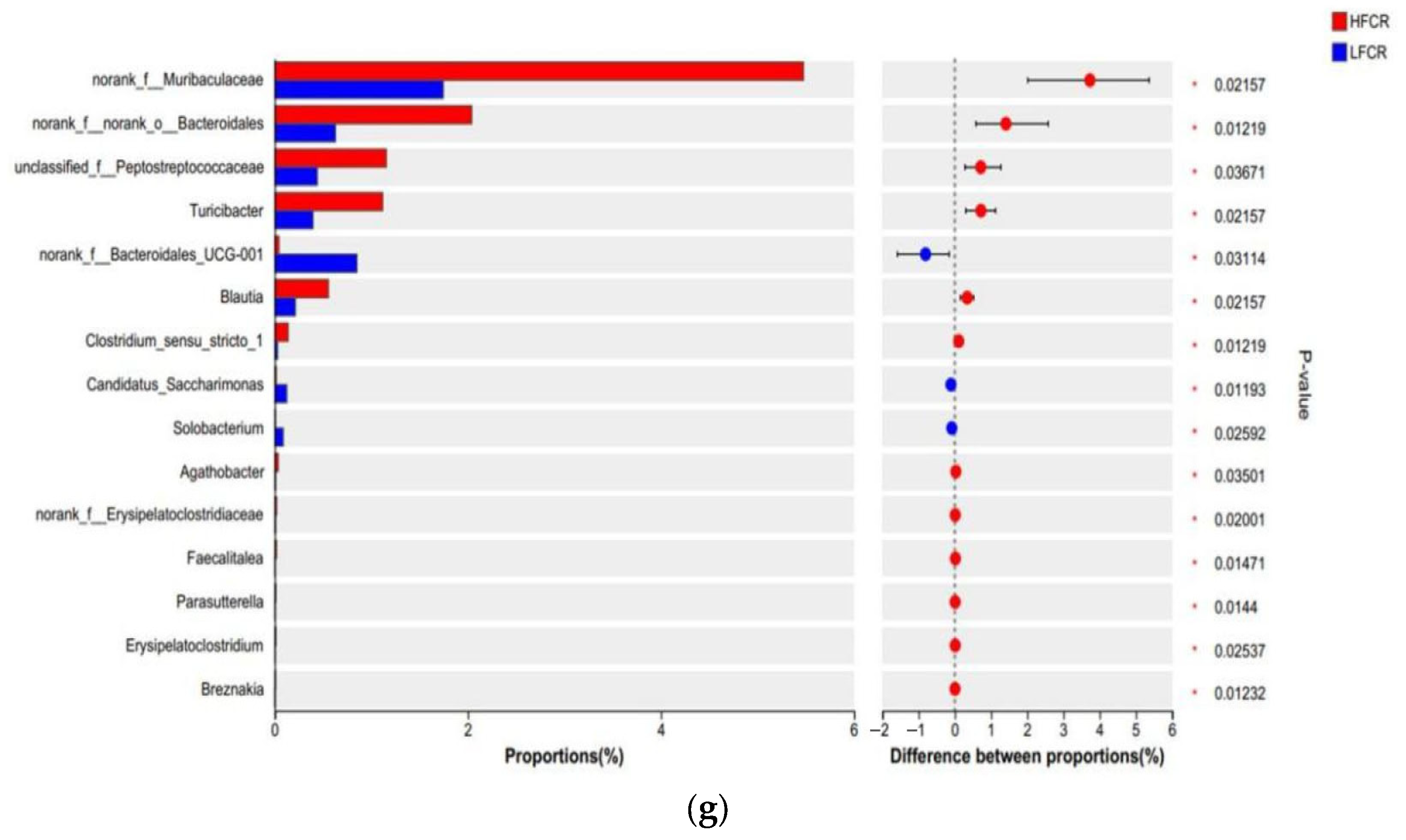

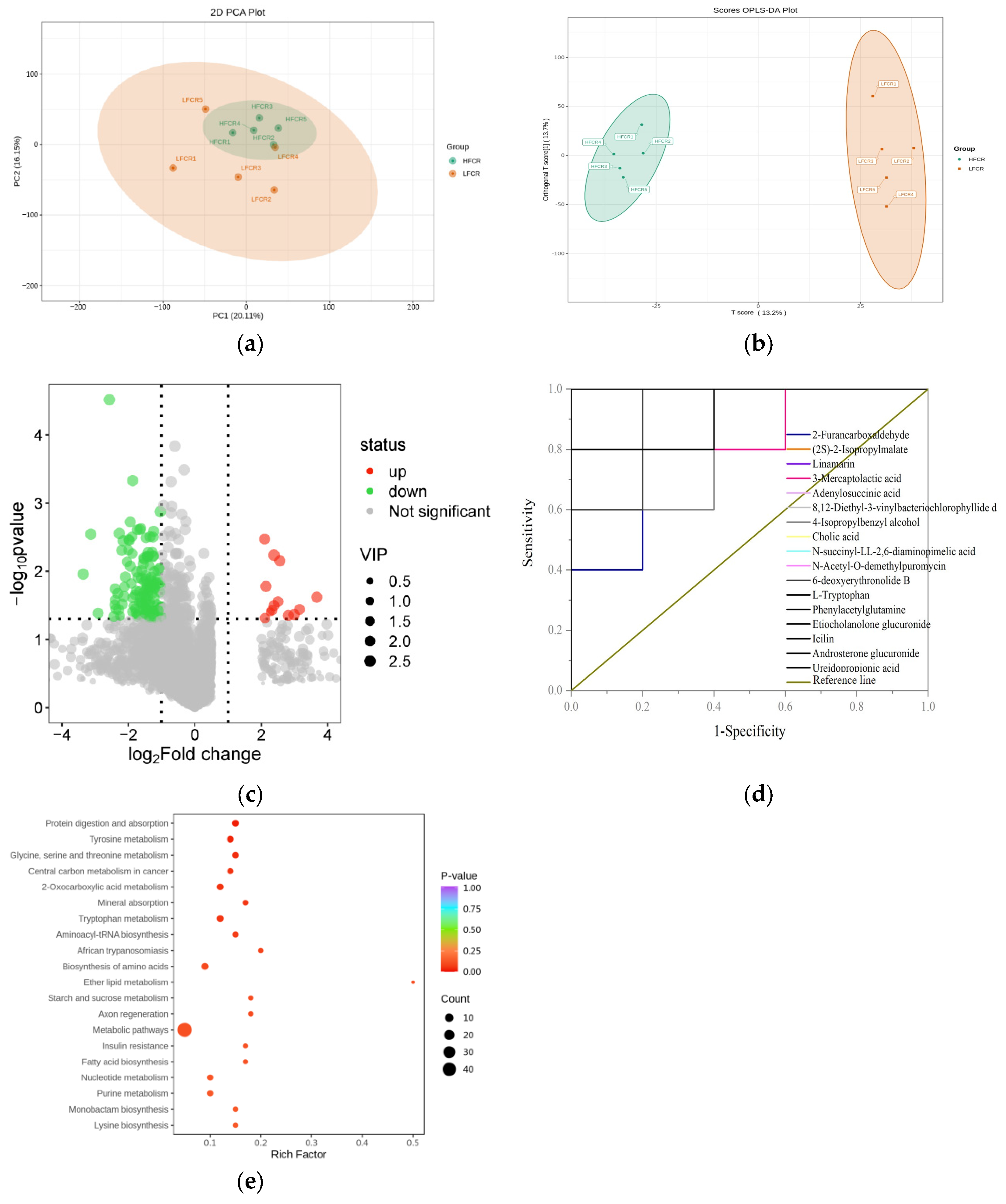
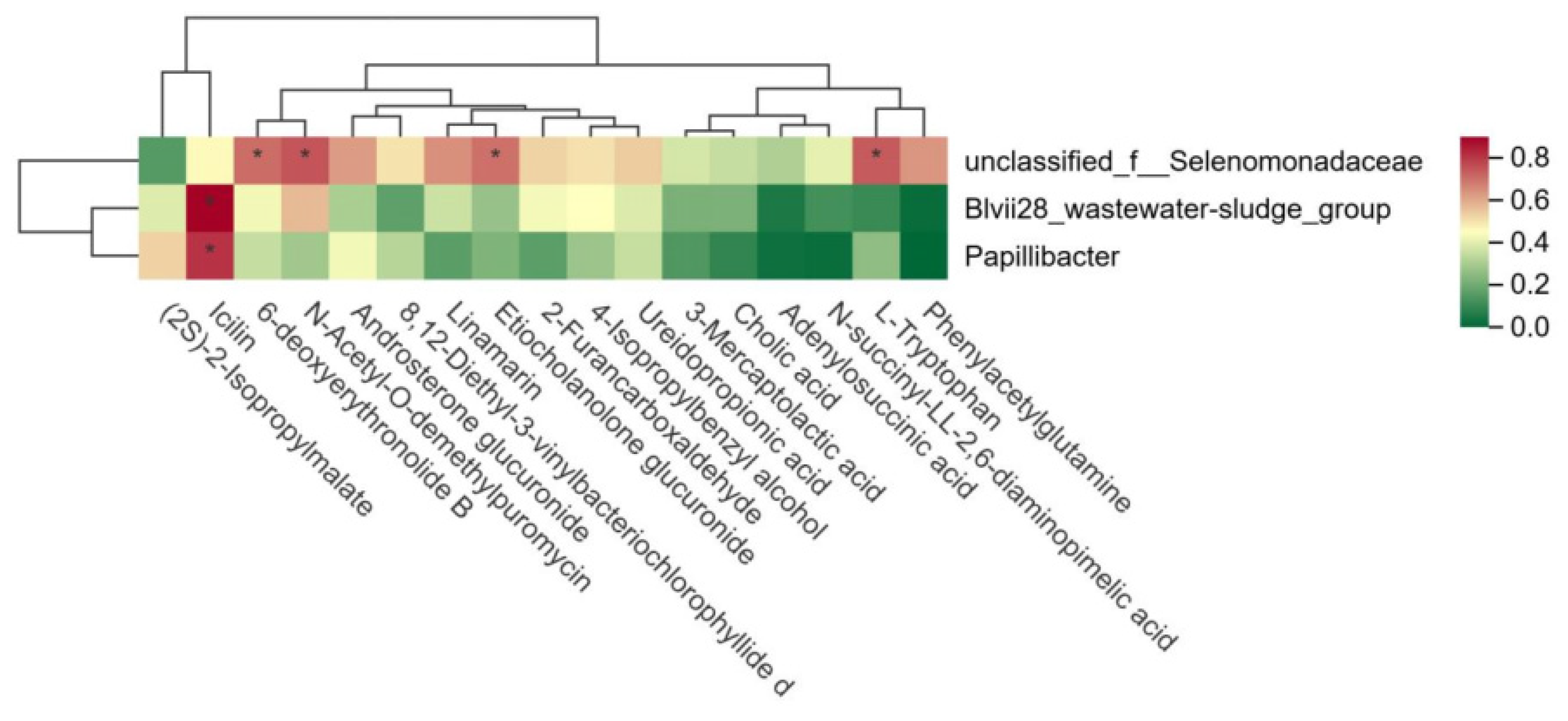
| Items | Content % |
|---|---|
| Ingredients | |
| Corn straw | 20.00 |
| Corn | 32.00 |
| Molasses | 4.00 |
| Soybean meal | 6.00 |
| Cotton meal | 8.00 |
| Corn bran | 15.30 |
| Corn germ meal | 11.00 |
| Limestone | 1.20 |
| NaCl | 0.50 |
| Premix 1 | 2.00 |
| Total | 100.00 |
| Nutrient levels 2 | |
| ME/(MJ/kg) | 9.93 |
| CP | 13.74 |
| EE | 2.74 |
| NDF | 35.99 |
| ADF | 20.34 |
| Ca | 0.71 |
| TP | 0.31 |
| Item | HFCR | LFCR | p-Value |
|---|---|---|---|
| Shannon | 4.03 ± 0.22 | 3.95 ± 0.2 | 0.560 |
| Simpson | 0.04 ± 0.01 | 0.05 ± 0.02 | 0.247 |
| Ace | 533.36 ± 58.21 | 536.75 ± 43.68 | 0.920 |
| Chao | 522.12 ± 58.38 | 542.18 ± 40.52 | 0.546 |
| Item | HFCR | LFCR | p-Value |
|---|---|---|---|
| Shannon | 4.71 ± 0.63 | 5.28 ± 0.21 | 0.089 |
| Simpson | 0.03 ± 0.03 | 0.01 ± 0.004 | 0.239 |
| Ace | 900.45 ± 167.45a | 1155.71 ± 59.77b | 0.012 |
| Chao | 889.51 ± 156.297a | 1130.68 ± 55.17b | 0.012 |
| Item | HFCR | LFCR | p-Value |
|---|---|---|---|
| Shannon | 4.95 ± 0.36 | 4.93 ± 0.54 | 0.925 |
| Simpson | 0.03 ± 0.03 | 0.02 ± 0.02 | 0.869 |
| Ace | 979.82 ± 133.66 | 1070.51 ± 164.26 | 0.366 |
| Chao | 959.69 ± 130.88 | 1062.47 ± 146.64 | 0.276 |
| Metabolites | VIP | p-Value | FC |
|---|---|---|---|
| Phenylacetylglutamine | 2.06 | 0.002 | 0.30 |
| 8,12-Diethyl-3-vinylbacteriochlorophyllide d | 2.32 | 0.003 | 0.42 |
| Androsterone glucuronide | 2.44 | 0.004 | 0.23 |
Disclaimer/Publisher’s Note: The statements, opinions and data contained in all publications are solely those of the individual author(s) and contributor(s) and not of MDPI and/or the editor(s). MDPI and/or the editor(s) disclaim responsibility for any injury to people or property resulting from any ideas, methods, instructions or products referred to in the content. |
© 2025 by the authors. Licensee MDPI, Basel, Switzerland. This article is an open access article distributed under the terms and conditions of the Creative Commons Attribution (CC BY) license (https://creativecommons.org/licenses/by/4.0/).
Share and Cite
Sun, G.; Han, X.; Liu, T.; Zhang, X.; Shi, A.; Yang, C.; Tao, J. Multi-Omics Integration Reveals the Impact of Gastrointestinal Microbiota on Feed Efficiency in Tan Sheep. Microorganisms 2025, 13, 1608. https://doi.org/10.3390/microorganisms13071608
Sun G, Han X, Liu T, Zhang X, Shi A, Yang C, Tao J. Multi-Omics Integration Reveals the Impact of Gastrointestinal Microbiota on Feed Efficiency in Tan Sheep. Microorganisms. 2025; 13(7):1608. https://doi.org/10.3390/microorganisms13071608
Chicago/Turabian StyleSun, Guohan, Xiaohong Han, Tonggao Liu, Xinrui Zhang, An Shi, Chong Yang, and Jinzhong Tao. 2025. "Multi-Omics Integration Reveals the Impact of Gastrointestinal Microbiota on Feed Efficiency in Tan Sheep" Microorganisms 13, no. 7: 1608. https://doi.org/10.3390/microorganisms13071608
APA StyleSun, G., Han, X., Liu, T., Zhang, X., Shi, A., Yang, C., & Tao, J. (2025). Multi-Omics Integration Reveals the Impact of Gastrointestinal Microbiota on Feed Efficiency in Tan Sheep. Microorganisms, 13(7), 1608. https://doi.org/10.3390/microorganisms13071608






